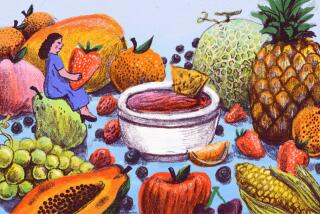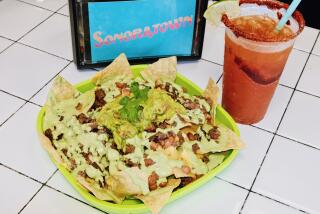Time may be ripe for growth of Fruiti Pops frozen fruit bars
The long spell of hot weather may have frayed nerves and fried the Southland, but Rudy Aguado is smiling because his Fruiti Pops fruit bars are more popular than ever.
Business has been booming so much for the small maker of paletas that Aguado, 60, has had to leave his desk job to drive truckloads of fruit bars to a distributor. His two dozen workers are too busy in his Santa Fe Springs factory making the bars.
“We’ve been working around the clock,” Aguado said. “So sometimes I got to step in.”
This summer’s heat was expected to help boost Fruiti Pops Inc. sales 14% for this year to $2.4 million from $2.1 million last year, he said. The operation produces about 135,000 frozen fruit bars a day during the busy summer season, which typically accounts for 45% of the company’s revenue.
More important, though, the popularity of his bars could help Aguado take his business more mainstream after catering to the Latino market through pushcarts and storefront shops for more than 30 years.
This fall, Aguado and his wife, Jackie, hope to move into local supermarket chains with some of the 40 flavors of their frozen concoction, including some non-fruit ones. Rudy Aguado said they are close to a deal with a distributor for major regional chains, which he declined to identify.
The time certainly is ripe. Demand for Latino products at mainstream stores is growing along with the Latino population, according to market research company IBISWorld.
And the buying power of Latino Americans is expected to skyrocket 48.1% over the next five years to $1.6 trillion, the research firm forecasted. That’s far ahead of the pace of the nation’s buying power overall, which is projected to grow 27.5% to $14.7 trillion.
IBISWorld analyst Nikoleta Panteva said despite the sluggish economic recovery, consumers are spending more on nonessential items such as desserts, which could boost Fruiti Pops’ chances of breaking into bigger markets.
“The growing population represents the growing demand for desserts like this,” Panteva said. “Mexican desserts are popping up and making us notice them more.”
It may be Aguado’s most daunting task as he looks for deals to put Fruiti Pops on the shelves of some larger supermarkets. There he’ll face such industry behemoths as Dole Food Co. and Nestle U.S.A., as well as larger Latino-oriented fruit pop makers Tropicale Foods Inc. in Chino and Paleteria La Michoacana Inc. in Modesto.
One way to make the move, he said, would be to arrange a deal much as Tropicale Foods did with its Helados Mexico paletas, which are distributed more widely with the help of Nestle.
“One of the things you have to do to make it is align yourself with a company that you can piggyback with and have them bring you in along with them,” Aguado said. “I feel I should have done that years ago.”
Aguado started planning for crossover appeal almost from the beginning of his venture in the late 1970s. He called his company and primary product Fruiti Pops, in contrast to competitors who used names such as La Michoacana, after the Mexican state where a type of fruit bar originated.
“Everyone eats fruit,” Aguado said, explaining his choice. “How many people know what a Michoacana is?”
The U.S. market for frozen fruit bars is small, only about $41.5 million of the total $8.3-billion ice cream and frozen confection industry, according to IBISWorld.
But, Panteva said, “There’s definitely this move toward healthy desserts and food in general. People are moving away from the high sugar and dairy and moving toward fresh fruit.”
The main differences between paletas and U.S. fruit bars, as far as Aguado is concerned, are how the fresh fruit is added and how the confection is mixed.
Fruiti Pops workers, for instance, squeeze the fruit partially by hand to make sure no peel or peel oils get into the blend, and then they mix it into a thick slush, rather than an airy, ice cream-like batter.
The result Aguado seeks: a fruit bar with more substance and more flavor.
The native-born New Yorker acquired his taste for paletas when he spent a few of his teenage years in Mexico City. So he knew as soon as he tasted his first U.S.-made fruit pop in the late 1970s that something was wrong. The strawberry flavor was lacking; the consistency was subpar.
“I figured we can do better than this,” Aguado said.
So at 29 he left his job at his stepfather’s market in Paramount and, with Jackie, gathered $13,000 from savings and other sources and began producing the paletas from a small commercial kitchen in Artesia in 1979.
Although other paleta makers have maintained small operations selling primarily out of their own storefronts, the Aguados have gradually grown by distributing through a network of ethnic and independent grocers.
It hasn’t always been a smooth ride for them. In July, Fruiti Pops recalled 178 dozen of its bestselling coconut dessert bars because the packaging didn’t warn consumers that the bars contained egg yolk, which could cause allergic reactions. Two years ago, the company recalled its mammee fruit bars because one of its suppliers, Goya Foods Inc., found a potential for typhoid fever in its fruit pulp.
Overall, though, business has been good enough to provide a comfortable income and a large Fullerton house with a big yard that enables Rudy Aguado to engage in his favorite hobby: bird-watching.
Although Fruiti Pops helped put Aguado’s four children through college, none of them want to take over the business, even though the opportunity to expand could double sales of the frozen treat.
So Aguado brushes off questions about retirement.
“I think once we develop a market where our bars are mainstream, I’ll think about it,” he said. “At this point, if we went mainstream and doubled our business, I would have another problem. But I guess having to get more equipment would be a good problem to face.”
dalina.castellanos@latimes.com
More to Read
Inside the business of entertainment
The Wide Shot brings you news, analysis and insights on everything from streaming wars to production — and what it all means for the future.
You may occasionally receive promotional content from the Los Angeles Times.










